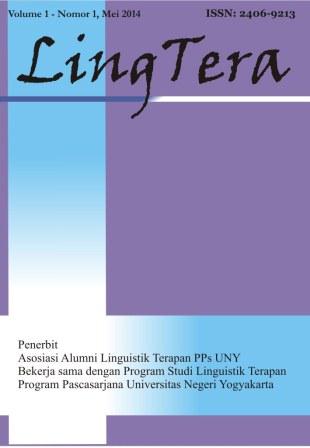Mood structures and their functions to reveal white's dominance: A critical discourse analysis in Doris Lessing's The Grass is Singing
DOI:
https://doi.org/10.21831/lt.v9i1.49131Keywords:
mood structure, mood function, white domination, black stereotypesAbstract
This discourse study aims to analyze the structure and function of the modes in the speech of the characters in The Grass is Singing concerning white domination over black people. This is a qualitative study with a critical discourse analysis approach. The findings conform Fairclough's theory (1989) that the mood structure, whether declarative, interrogative, or imperative, can show the speaker's dominance and power. In the declarative mode, the speaker or the person giving the information tends to be in a higher position than the interlocutor. In the interrogative and imperative modes, the person who asks for both information and action from the interlocutor is generally more dominant. These findings reveal that white people consider their group to be superior to black people even though within the white group itself a social class division exists where those who are more successful will be more powerful than people who are struggling economically.
References
Bano, A. and Davidson, L. M. (2017). A critical analysis of Doris Lessing's The Grass is Singing. International Journal of English Research, 3(3), 28-29.
Chueasuai, P. (2017). The Interpersonal Metafunction and Translation of Power Relations: A Case Study of Fifty Shades of Grey, Manusya: Journal of Humanities, 20(3), 1-22. https://doi.org/10.1163/26659077-02003001
Das, H. (2019). Racism in Doris Lessing's The Grass is Singing and Toni Morrison's Beloved. American Journal of Research, 5(6), 14-40. http://doi.org/10.26739/2573-5616-2019-6-2
Eggins, S. (2004). An introduction to systemic functional linguistics (2nd Ed.). Continuum.
Fairclough, N. (1989). Language and power. Longman.
Fishburn, Katherine. (1994). The Manichean Allegories of Doris Lessing's The Grass is Singing. Research in African Literatures, 25 (4), 1-15.
Hamid, U. (2021, May 3). Bhinneka Tunggal Ika? Inside Indonesia. https://www.insideindonesia.org/bhinneka-tunggal-ika
Kakanaeini, F. (2016). Discourses and Ideologies of Whites: The Postcolonial Study of The Grass Is Singing. International Conference on Literature and Linguistics. http://www.irlit2016.com/
Kamalu, I. & Tamunobelema, I. (2013). Linguistic Expression of Religious Identity and Ideology in Selected Postcolonial Nigerian Literature. Canadian Social Science, 9(4), 78-84
Keum, B. T., & Miller, M. J. (2018). Racism on the Internet: Conceptualization and recommendations for research. Psychology of Violence, 8(6), 782–791. https://doi.org/10.1037/vio0000201
Kirton, T. (2010). "Racial Exploitation and Double Oppression in Selected Bessie Head and Doris Lessing Texts" Dissertation. University of Fort Hare (East London Campus).
Lock, G. (1996). Functional English grammar: An introduction for second language teachers. Cambridge University Press.
Lessing, D. (1989). The Grass is Singing. Paladin.
Majumder, S. (2021). The "˜Turner(s)' of Discourses: A Reading of Doris Lessing's The Grass is Singing. The Criterion: An International Journal in English, 12(3), 216-222.
Mills, S. (2004). Discourse. Routledge.
Mullet, D. R. (2018). A General Critical Discourse Analysis Framework for Educational Research. Journal of Advanced Academics, 29(2), 116–142. https://doi.org/10.1177/1932202X18758260
Noor, M., et. al. (2016) Systemic Functional Linguistics Mood Analysis of the Last Address of the Holy Prophet (PBUH). International Journal of Language and Linguistics, 4 (1-1), 1-9. https://doi.org/10.11648/j.ijll.s.2016040101.11
Quirk et al. (1985). A comprehensive grammar of the English language. Pearson Longman.
Reisigl, M. & R. Wodak. (2005). Discourse and discrimination: Rhetorics of racism and anti-Semitism. Routledge.
Schlueter, Paul. (1974). The novels of Doris Lessing. Southern Illinois UP.
United Nations. (2022, March 21). International Day for the Elimination of Racial Discrimination, 21 March. United Nations. https://www.un.org/en/observances/end-racism-day
Wodak, R. and Meyer, M. (2009). Methods of Critical Discourse Analysis (2nd Ed.). SAGE Publications.
Yuen, N. W., (2019, June 4). How Racial Stereotypes in Popular Media Affect People "” And What Hollywood Can Do to Become More Inclusive. Scholar Strategy Network. https://scholars.org/contribution/how-racial-stereotypes-popular-media-affect-people-and-what-hollywood-can-do-become
Downloads
Published
How to Cite
Issue
Section
Citation Check
License
LingTera allows readers to read, download, copy, distribute, print, search, or link to its articles' full texts and allows readers to use them for any other lawful purpose. The journal allows the author(s) to hold the copyright without restrictions. Finally, the journal allows the author(s) to retain publishing rights without restrictions.
- Authors are allowed to archive their submitted articles in an open-access repository.
- Authors are allowed to archive the final published article in an open-access repository with an acknowledgment of its initial publication in this journal.

Psychology, Evaluation, and Technology in Educational Research is licensed under a Creative Commons Attribution-ShareAlike 4.0 International License.
Based on a work at https://petier.org/index.php/PETIER.









